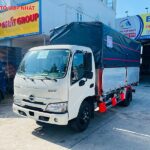Truck modification is a popular solution for individuals and businesses seeking to optimize transportation capabilities and save costs. This article provides detailed information about regulations, conditions, costs, and types of truck modifications in Vietnam.
Illustration of the truck modification process
What is Truck Modification?
Truck modification involves altering the structure, dimensions, or function of a vehicle compared to its original design. This may include installing a new cargo box, adjusting the size of the cargo box, upgrading the drivetrain, or other changes to meet specific usage needs.
Purposes of Truck Modification:
- Increased Transportation Capacity: Increasing cargo capacity, adjusting cargo box size to suit the type of goods to be transported.
- Improved Efficiency: Improving the engine, drivetrain to help the vehicle operate efficiently and save fuel.
- Meeting Diverse Needs: Flexible adjustment of vehicles for different uses in construction, agriculture, transportation…
Note: Truck modification must comply with legal regulations and ensure traffic safety. The modification process must be performed by a qualified facility and meet technical standards.
Regulations on Truck Modification
According to Circular 43/2023/TT-BGTVT amending Circular 85/2014/TT-BGTVT, effective from February 15, 2024, truck modification must comply with the following regulations:
- No Modification: Suspension, steering, brakes (except in certain special cases).
- No Modification: Converting tractor trucks into other types of vehicles (except specialized vehicles).
- No Change: Tire size, number of axles, axle spacing, and wheel track (except in certain special cases).
- No Increase: Overall length of the vehicle (except specialized vehicles and changing the front and rear panels of passenger vehicles).
- No Increase: Cargo box internal dimensions, tank volume.
- Payload Capacity: After modification, it must not exceed the original design.
- Technical Parameters: Must comply with the regulations in Circular 42/2014/TT-BGTVT.
- No Use: Used systems or assemblies (except specialized equipment, engines).
- Vehicles Transporting Dangerous Goods: Need to be certified for quality and technical safety by a competent authority.
- Modification Limits: Each vehicle can only be modified for 1 of the 2 main assemblies (engine or frame) and no more than 3 other systems (cab, body, brake system, suspension, fuel).
Illustration of truck modification regulations
Conditions for Truck Modification
Vehicle Age: Under 15 years from the date of manufacture (over 5 years if converting a specialized vehicle into another vehicle; over 6 months from the date of technical safety inspection for imported vehicles that have not been used).
Vehicle Condition: Frame, engine, transmission system, and steering are intact.
Required Documents:
- Certificate of technical safety and environmental protection inspection is still valid.
- Vehicle registration certificate and vehicle ownership certificate.
- Technical documents from the manufacturer.
Types of Truck Modification
Cargo Box Modification: Changing the size, type of cargo box (closed to tarpaulin, specialized such as tanks, cement trucks, livestock trucks…), installing equipment on the cargo box (cranes, excavators, concrete mixers…).
Other System Modifications: Engine, transmission, brakes, steering.
Truck Modification Costs
Depends on the extent and type of modification:
- Cargo Box Modification: Changing the size, type of cargo box, installing equipment.
- Engine Modification: Changing to a more powerful, more efficient engine.
- Transmission, Brake, Steering System Modification: Upgrading the system.
Truck Modification Procedures
- Prepare Documents: Vehicle registration documents, technical drawings or post-modification design documents, certificate of technical safety inspection.
- Submit Documents: At the registration management agency or competent authority.
- Inspection and Maintenance: After modification, regular inspection and maintenance are required.
Penalties for Violating Modification Regulations
Unauthorized cargo box modifications are subject to a fine of VND 2,000,000 – 3,000,000 (Decree 123/2021/ND-CP).
Vehicles circulating with cargo box technical specifications that do not match the inspection certificate are subject to a fine of VND 6,000,000 – 8,000,000 for individuals, VND 12,000,000 – 16,000,000 for organizations (Article 30 of Decree 100/2019/ND-CP, amended by Decree 123/2021/ND-CP).
Conclusion
Truck modification offers many benefits but requires compliance with legal regulations and ensuring traffic safety. Choosing a reputable, experienced unit and following the correct procedures is an important factor to ensure efficiency and safety when modifying a truck. Research the information carefully and choose the solution that suits your needs.
